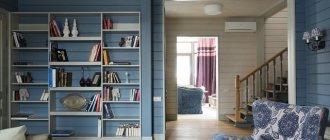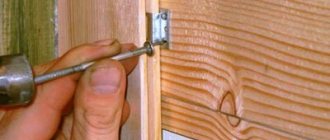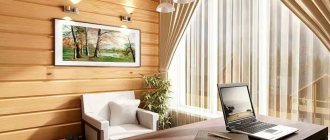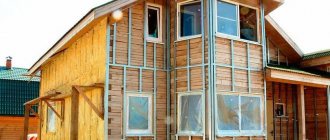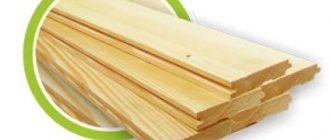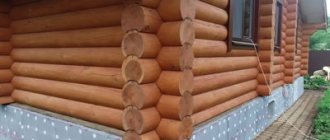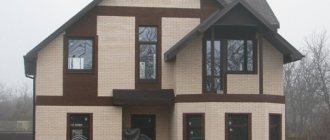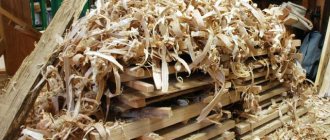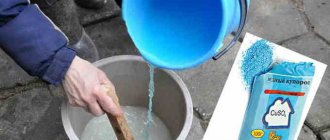Wooden lining is a beautiful, natural material. It is not surprising that so many users around the world prefer it as a finishing and facing material.
The environmental friendliness and natural beauty of wood not only decorates the room, but also creates a certain microclimate in it. And the lining covered with a thick coating (paint, varnish) allows you to create any decor.
But wood has a significant disadvantage that affects the performance characteristics of the lining - it is subject to rotting, various damage, and also tends to darken.
This article is intended for those who want to protect and at the same time preserve the lining in its natural form. Let's consider step by step how and what is the best way to coat (impregnate, treat, paint) wooden lining (euro lining).
I must say that the “take a brush, paint and paint” method is good precisely because of its simplicity. But how long will wood painted this way last? Wouldn't it be better to take a more thorough and correct approach?
Proper painting of wooden lining consists of 4 stages:
Tips for choosing a finishing coating for wooden lining
- color . Since stain or paint changes the color or shade of the lining, you need to use this property. For example, light shades visually increase the space. The use of different colors/shades allows you to zone the room;
- compound . The prefix “bio” after the name of the varnish indicates the absence of harmful substances. This composition can be used for interior work;
- manufacturer . Many domestic analogues of lining varnish or paint can create worthy competition for foreign goods. At the same time, the price of the product will be more humane.
How and with what to paint the lining in the bathhouse and steam room
Wax composition Evrotex-Sauna for lining in a bathhouse Due to the high temperature, it is better not to paint the lining in a bathhouse, but to treat it with protective compounds.
An excellent solution would be to use wax compounds, for example, Evrotex-Sauna. This coating is suitable for use in conditions of high temperature and cyclic intensive humidification.
Advice. You only need to apply the varnish once in the sauna. In the dressing room - you can make several layers.
How and with what to paint the lining on the veranda
The veranda or terrace is exposed to the greatest influence of atmospheric factors, so the material must be resistant. First coat with a layer of primer, and then 2-3 layers of varnish or paint.
How and with what to paint the lining inside/outside the house
There are no particular differences in painting a house outside or inside. The only difference is in the coatings used. Varnish/paint for interior work must meet environmentally friendly requirements. For outdoor work, it is more important that the coating can withstand moisture, temperature changes, and exposure to UV rays. The same type of paint can be used inside and outside a building. The difference is in the number of layers applied.
How to paint lining correctly - tool
To paint the lining you can use:
- brush. They are convenient because they allow you to paint wood in corners and hard-to-reach places. The paint is applied most evenly with a brush;
Advice. To apply the paint with a brush evenly and avoid smudges, you need to immerse the brush halfway in the paint.
- roller Allows you to paint quickly. However, to obtain a uniform layer you need to paint several times;
- spray. Allows you to get the job done as quickly as possible. But it increases paint consumption;
- mitten (chain-shaped). It is convenient to use a glove to paint (impregnate) the places where the lining joins (frames) the pipes;
- foam sponge.
What difficulties may arise when protecting wood?
You already know that protecting wood helps preserve its mechanical properties, durability and aesthetics. It protects them from the harmful effects of temperature, sunlight, moisture and biological factors. However, you may encounter many obstacles when protecting this material. This raw material is heterogeneous and its structure is varied. Products that protect the material and how they are applied should be selected depending on the type of wood, where it will be used - outdoors or indoors - and the intensity of use.
Resin content can be a problem when preserving wood. Basically, this material must be free of resin, because the varnishes with which you can protect wooden elements do not allow adequate adhesion to the substrate. Varnished wood with a high resin content will take longer to dry, and this substance will soften the protective coating. You should know that its formation can be greatest near the nodes. You may notice this if you choose water-based wood protectants. After painting, brown spots will appear at the nodes.
Wood paneling painting technology
- Before painting or applying varnish/paint, they must be mixed well. This way they will lie more evenly;
- a test paint will allow you to understand what the painted surface will look like;
- It is better to apply the paint in several thin layers. This way, each layer will dry faster and the coating will be applied more evenly;
- the next layer of paint/varnish should be applied only after the first one has completely dried;
- When painting the lining, you need to leave gaps of 2-3 cm at the top and bottom of the panels. This will allow the tree to breathe. And the gaps themselves can be closed with decorative plinths;
- to avoid obtaining different shades of wood, it is better to paint with paint at a time, using material from one batch;
- if there is a need to interrupt work, try to make sure that the “seam”, the border of the painted and unpainted area, is not in a visible place;
Tips for storing an open can of paint:
If work is interrupted for a long time, then in order to prevent a film from appearing on the surface of the paint, you can put cardboard impregnated with drying oil on the surface.
If a film appears, its particles may fall on the surface to be painted. In this case, it is better to cover the surface with foam rubber and dip the brush through it.
- a more saturated color/shade can be obtained if you apply the paint several times (up to 4). Further increasing the number of layers will have no effect;
- Do not allow paint/varnish to dry too quickly. This may cause the painted layer to crack. Professionals do not recommend applying paint/varnish in direct sunlight.
Protective compounds against pests
The best wood protection products with insecticidal properties will help prevent the appearance of uninvited guests: beetles, termites, ants, etc., which often carry fungal spores and also make passages in the bark. For example, wood-boring beetles are capable of gnawing tunnels up to 40 m long in a tree. Moreover, the damage can be so significant that the boards lose strength and collapse from the inside even with a small number of entrance holes. There are often cases when, for the construction of a house, lumber is purchased that is made from a tree already infested with beetles, the presence of which only becomes evident over time.
Meffert
Woodmaster Anti-bug, biocidal composition (“Rogneda”) (pack of 5 l - 299 RUR)
"Rogneda"
Anti-beetle for wood Propitex (Meffert) (11 kg pack - 423 RUR)
Neomid
StopBeetle Neomid 100 for the destruction of wood-boring insects, the concentrate is diluted 1:4 (pack of 5 l - 1,300 rubles).
Most protective products against wood-boring beetles and other insects are designed to not only prevent their appearance, but also destroy them at all stages of development. In the latter case, the insecticidal solution is usually applied in a greater number of layers than during preventive treatment, and concentrated products are diluted with less water.
It is more difficult to get rid of beetles and their larvae in heavily damaged wood: the drug is sequentially injected into the entrance and exit holes using the injecting method, and after 2 weeks the procedure is repeated. The cost of 5 liters of Anti-bug product is from 299 rubles.
Some modern antiseptics can not only prevent damage to wood, but even treat material that has begun to deteriorate.
Threats
Rot and mold attack the picket fence
Before proceeding directly to the consideration of solutions suitable for wood processing, let's take a closer look at the possible dangers:
| Threat | Description |
| Rotting | This is the most common and dangerous problem, caused by water penetrating through the pores in the wood surface. Once inside, the liquid causes the cellulose to break down. |
| Mold | In addition to destructive effects, moisture can become a source of infection of the tree with fungus, changing its color and emitting unpleasant odors. |
| Pests | Wood can be a desirable treat for some types of insects. |
| Fire | Wooden logs are even used to heat solid fuel stoves, which indicates the flammability of this material. In the event of a fire, it releases a large amount of thermal energy, spreading the fire. |
Photo of a wood borer beetle feeding on wood
As you can see, there are quite a lot of factors that can ruin expensive material, so it’s better to take care of its protection in a timely manner.
Conclusion
Wood needs additional protection from the harmful effects of the environment. This can be provided by varnishes and paints for wooden surfaces, the choice of which is quite wide today in specialized stores.
Coating wooden structures with paints and varnishes extends their service life
The video in this article will provide additional resources. Protect wooden structures in a timely manner.
Impregnations
These compositions are distinguished by the fact that they penetrate deep into the structure of the material and do not create a film on the surface. Some of the solutions discussed below can be used as a full-fledged protective layer, others can only be used as preparation for finishing.
The most popular options are:
- Stains give the surface a certain shade, but do not protect it from water and other influences. The compositions can be water-based, alcohol-based or oil-based. They differ in properties, but perform the same function. The choice depends on the specific conditions, but the most popular are water-based solutions; they are distinguished by their low price and safety;
Before covering the lining with stain, you should choose the desired color
- Acrylic-based impregnations are often called glazes. They differ from stains in that they tightly close the pores of the wood, so they can also be used as a finishing finish. If you are thinking about how to cover the lining to prevent it from darkening, then this option will come in handy. Acrylic emulsion reliably protects against ultraviolet radiation, and the surface retains its original color for a long time;
If you are thinking about how to cover the lining outside the house, then choose acrylic compounds with wax, they are especially reliable
- How to cover the lining outside the house or inside the premises to protect them from mold? Antiseptic compounds provide excellent protection against fungus and extend the life of wood significantly. Such solutions are used exclusively as a preparatory layer; the surface is always covered with something again;
Antiseptic impregnations can tint wood to the desired color
- If you are thinking about the best way to coat eurolining in order to increase its resistance to fire, then the best option would be special fire retardant compounds. They also serve as a preparatory layer before the main coat. A universal fire-bioprotective solution can be an excellent solution; it makes the material resistant to both fire and mold.
Universal formulations are very popular
Choose products from well-known manufacturers. You won’t be able to check its quality by eye, so it’s better to consult to find out which formulations have proven themselves best.
Tree at home - how to care for a tree at home?
Every day, it is enough to wipe wooden furniture in the house or wooden ceiling beams with a damp cloth to remove dust and dirt. After you're done cleaning your wood furniture, you still need to dry it with a paper towel. Do not use harsh chemicals for cleaning as they may damage the wood's protective coating.
Any scratches and dents on wooden countertops or furniture can be filled with a special putty of the appropriate color. Lightly rub the damaged area with 120-grit sandpaper to mask the defect. Then apply a little excess putty, let everything dry and sand the surface with sandpaper. After sanding, it is also necessary to renew the varnish with the same level of gloss as on the rest of the furniture.
Inside, wood is less susceptible to the harmful effects of moisture, insects and microorganisms, but it should still be provided with proper protection and durability. This will be possible thanks to the appropriate impregnations for this material, in addition, you will be able to adjust the shade and color of the wood to the intended interior.
Paints
This type of product differs from the ones described above in that an opaque film is created on the surface. Therefore, if you need to get a specific color, then this option is perfect.
Paint allows you to give the lining any color
There are also many composition options; before covering the lining in the house, you need to choose a specific solution:
- Oil paints are a traditional option that is being used less and less these days. The composition has good protective properties, but it is short-lived; after a year or two, the coating needs to be renewed. Another disadvantage is the small selection of colors;
Oil paints are rarely used
- Alkyd paints are very popular because they adhere very well to the surface and do not lift the fibers of the material. The composition is distributed in a thin layer and forms a durable film that protects well from moisture and has good wear resistance;
This option has a much wider choice of colors.
- Acrylic compositions make it possible to create an attractive and durable coating for eurolining. They are absolutely harmless, which allows them to be used in premises for any purpose. The paints are water-based and come in a huge variety of shades. You can simply buy white composition and pigments and create your own unique color.
Acrylic compositions retain the brightness of colors for a very long time
